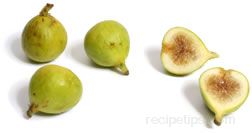The Green Fig (green and yellow varieties), include popular figs such as the Adriatic, the Brunswick, the Calimyrna, and the Kadota. Golden tan in color, the skins of the Adriatic and the Calimryna cover an inner flesh that is sweet flavored and good to eat out of hand. The Adriatic has a higher sugar content and is commonly used for making Fig bars or sweet fillings and pastes. Medium to large in size, the Brunswick has a brown outer skin and a rich flavored inner flesh. The Kadota Figs have a juicy, thick greenish-tan skin covering an almost seedless, creamy amber-colored flesh that is sweet in flavor. A favorite Fig for canning and drying, the Kadota may also be referred to as the Dattero, Dottato, or White Kadota. In addition to the varieties mentioned, others include the Alma, Bianci, Blanche, Brunswick, Conadria, Excel, Galbun, Gillette, Green Ischia, Ischia, Jurupa, King, Lattarula, LSU Gold, Mary Lane, Panachée, and Tena.
Black Figs (dark varieties), such as Black Mission grow with a dark purple to black skin covering a watermelon colored flesh that is dry in texture and sweet in flavor. This variety, also known as California Black or Franciscana, is one of the most common Figs available. The purple Figs, also considered part of the dark varieties, provide the sweetest flavor and juiciest flesh of all varieties. Popular purple varieties include the Brown Turkey and Celeste. The Brown Turkey, also known as the San Pedro or San Piero, has a tan to copper colored skin with a rich red flesh that is somewhat mellow in flavor. Grown with a tan to violet colored skin covering a red-violet flesh, the Celeste is a smaller to medium-sized Fig with a mildly sweet pulp. Other varieties include the Beall, Black Jack, Bordeaux, Brown Turkey, Celeste, Early Violet, Flanders, Hardy Chicago, Hunt, Ischia Black, LSU Purple, Nero (Barnisotte, Brogiotto Nero, Neveralla, Osborn Prolific, Pasquale, Petite Negri, Royal Vineyard, and Sal's Fig.
When making foods with Figs, if the Fig suggested in the recipe is not available, it is best to substitute it with a variety that comes from the same color category. Since Figs perish easily, they are cooked into jams and preserves or dried for longer lasting use. When they are fresh, Figs can be eaten raw, served in salads, cut into quarters and prepared as an appetizer, or served as a dessert. Figs are also used in making a variety of baked goods as well as preserves and sauces. When preparing, Figs can be baked, poached, grilled, and sauteéd. The sweet flavor of this food item goes well with pork (especially pancettta and prosciutto), lamb, poultry, and cheese such as Gorgonzola or Goat cheeses. Figs that have been harvested too early can be ripened at room temperature. When selecting, choose those that are soft but not mushy and make sure they are not sour smelling. Figs with light stretch marks on the outer skin denote Figs that are sweeter in flavor. When storing, keep Figs in a refrigerator, tightly wrapped or in an enclosed container for 1 to 2 days. Dried Figs should be stored in their original package tightly sealed. They can be stored at room temperature for approximately 3 to 4 weeks. For longer storage, up to 6 months, store in the refrigerator.
Dried Figs may be referred to as "Figlets" to denote their smaller size. A problem that occurs occasionally with dried Figs is that they are infested with worms. It is suggested that all Figs be checked for infestation before they are used. Check 3 or 4 Figs from the package by slitting them open lengthwise and then turning them inside out. Check the inside thoroughly for the presents of webbing. The webbing is an indication of worms. If no webbing is found, the package should be OK. If any signs of the webbing are found, discard the entire package. This problem occurs in both domestic and imported figs so it is best to check them every time before using.









